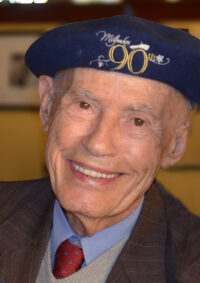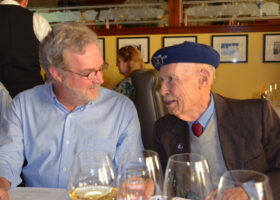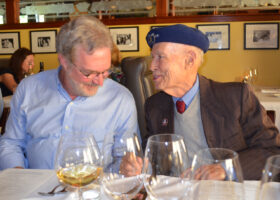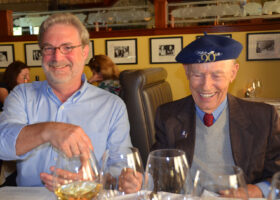An Extraordinary Life
Mijenko “Mike” Grgich, 1923 – 2023
 I last saw Mijenko “Mike” Grgich at Marvin Shanken’s Wine Spectator Magnum Party in Napa Valley. All of Napa’s best winemakers were there, and all were toting a magnum (1.5 liter) of wine and a guest. For the last page of his autobiography, Mike chose a picture of himself taken at that party, followed by the words, “At 92, I was not the oldest vintner … but maybe I will be when I’m 100!”
I last saw Mijenko “Mike” Grgich at Marvin Shanken’s Wine Spectator Magnum Party in Napa Valley. All of Napa’s best winemakers were there, and all were toting a magnum (1.5 liter) of wine and a guest. For the last page of his autobiography, Mike chose a picture of himself taken at that party, followed by the words, “At 92, I was not the oldest vintner … but maybe I will be when I’m 100!”
Mike reached the century milestone on April 1st and passed away at his home in Calistoga on December 13th. And while the man may be gone, his legacy will live on as long as wine is produced in America. He led an extraordinary life and helped transform Napa Valley, once a fledgling wine region, into a prestigious player on the global wine stage.
 What I will remember about Mike will not be his profound accomplishments, although they are many, I will remember his generous sense of humor, his gentle smile, and his genuine love of life. When we first met in 2014, Mike had just returned to Napa Valley from Palm Springs. Over dinner at Cole’s Chop House in downtown Napa, he leaned close to me and said, “Jesus spent 40 days in the desert to cleanse his spirit.” He smiled, shrugged, and added, “I spent the winter in Palm Springs so perhaps I too, came back a better person.”
What I will remember about Mike will not be his profound accomplishments, although they are many, I will remember his generous sense of humor, his gentle smile, and his genuine love of life. When we first met in 2014, Mike had just returned to Napa Valley from Palm Springs. Over dinner at Cole’s Chop House in downtown Napa, he leaned close to me and said, “Jesus spent 40 days in the desert to cleanse his spirit.” He smiled, shrugged, and added, “I spent the winter in Palm Springs so perhaps I too, came back a better person.”
 Mike Grgich was a paradox. By his own account he was enormously frugal yet he was a tireless philanthropist who gave back to the industry he loved and the country he fled. He lived his life in the relentless pursuit of perfection, yet chose to make wine, an occupation where nature turned perfection into a perpetually moving target. And Mike was a deeply spiritual man who could surprise you with an offhand joke about Jesus.
Mike Grgich was a paradox. By his own account he was enormously frugal yet he was a tireless philanthropist who gave back to the industry he loved and the country he fled. He lived his life in the relentless pursuit of perfection, yet chose to make wine, an occupation where nature turned perfection into a perpetually moving target. And Mike was a deeply spiritual man who could surprise you with an offhand joke about Jesus.
 Conversation with Mike was a stream of parables; life-lessons strung together and given dimension through his charming and self-deprecating sense of humor. You had to pay close attention to his tales or you might miss their meaning, or worse, their punchline. As I listened to his life’s story, it struck me that he embraced life with the wide-eyed joy of a child even though the circumstances of that life might have defeated a lesser man.
Conversation with Mike was a stream of parables; life-lessons strung together and given dimension through his charming and self-deprecating sense of humor. You had to pay close attention to his tales or you might miss their meaning, or worse, their punchline. As I listened to his life’s story, it struck me that he embraced life with the wide-eyed joy of a child even though the circumstances of that life might have defeated a lesser man.
More than once Mike Grgich was marked for death, but he survived the horrors of World War II and escaped from Communist Yugoslavia in 1954. When Mike was a teenage shopkeeper in the small Croatian village of Desne, Italian soldiers arrived and dragged the local priest from his bed and murdered him for ringing the church bell.
The soldiers, in a token search for partisans, gathered 50 village men including Mike’s sick father, and tied them together. Mike ran from his shop, found the commander and pleaded for his father’s life. The commander released the father in exchange for the son then marched Mike and the others to a long grave by the riverside. For several hours, the bound men stood before the deep pit, awaiting their fates, machine guns at their backs. Eventually they were loaded into trucks and taken to prison. After four days of interrogation Mike was set free but his sister’s husband was not released and was never seen again.
As the occupation ended, Nazi soldiers burned Mike’s village to the ground, and even though one threat was gone, Mike and his family continued to fear for their lives as the Communist partisan, Josip Broz Tito rose to power after the war.
In his autobiography Mike wrote;
The coming of Communism created a life that normal Americans can’t imagine. If you owned a business, they would take everything you owned and then kill you. When the Communists came to Desne, they looted everything from my store. Luckily I was warned that they were looking for me, that I was on their “to-be-killed list.” I escaped to Metković and survived the first blow of the post-war world.¹
A few years after the war’s end, Mike was accepted into the University of Zagreb enology and viticulture department. This may have been the defining moment in Mike’s life, the seminal event that set Mike on the path to America. One rainy day in Zagreb, Mike forgot his umbrella on a streetcar and since he could not afford a new one, he bought a practical French beret. Not only did it keep his head dry, he could fold it up and keep it in his pocket. Today this iconic beret sits in the Smithsonian Institution in Washington DC.
As Mike was completing his enology studies in 1954 he was granted a student internship beyond the Iron Curtain. He was aware that once he obtained his degree he would never be allowed to leave Communist Yugoslavia, so with $32 hidden in the heel of his shoe he crossed into West Germany and an unknown future. In West Germany his application for political asylum did not get him a ticket to America; it got him sent to a refugee internment camp. Eventually he was freed by his host family and Mike resumed his dream of immigrating to America and the fabled paradise called California.
While waiting years for an American visa, Mike learned he could get into Canada due to an urgent need for lumberjacks. If you’ve ever met the petite Mr. Grgich you know just how comical that sounds. Nonetheless Mike set off for Canada’s vast Yukon – but in a twist of fate that may have benefitted the Canadian lumber industry – Mike accepted a job as a Vancouver dishwasher instead.
In 1958 Mike finally realized his dream of working in California, where he honed his craft under the tutelage of Napa legends Lee Stewart of Souverain, Brother Timothy at Christian Brothers, André Tchelistcheff at Beaulieu Vineyard, and Robert Mondavi. The first wine Mike created at the Robert Mondavi Winery was the 1969 Cabernet Sauvignon that won a blind tasting sponsored by the Los Angeles Times, the first event of its kind. The Wine Spectator subsequently rated the wine 99 points calling it “possibly the best cab ever made in California”.
Mike later wrote;
Some writers pointed out that I had brought Tchelistcheff’s classical training to Mondavi’s drive and innovation, but it was more than that … I was lucky to have been able to work with men who were giants in the world of wine, and I absorbed their knowledge. I put together everything I learned from each of them. So, although I made that wine, it was also my father, the enology degree I received from the University of Zagreb in Croatia, Lee Stewart, Brother Timothy, André Tchelistcheff, my education and my experience that made the best Cabernet in California in 1969.²
In 1972 Chateau Montelena was in need of a winemaker and in addition to a salary, partner Jim Barrett offered Mike one percent per year ownership in the winery. Mike accepted the offer and his move to Montelena became the defining moment in the history of the California wine industry. Mike’s first release was the 1972 Chardonnay which was hugely successful with critics and tasting groups. It was the watershed 1973 Chardonnay, however, that created the shot heard around the wine world and eventually ended up in the Smithsonian Institution along with his suitcase, textbooks and the famous beret.
The Paris Wine Tasting of 1976 was a wine tasting event organized by Englishman Steven Spurrier, who at the time was a Paris wine merchant and educator. The blind tasting, held on French soil and judged exclusively by French judges, pitted six California Chardonnays against four world-renowned Chardonnays from Burgundy, and six California Cabernet Sauvignons against four prestigious Cabernet Sauvignon-based blends from Bordeaux. When the points were tallied, Mike Grgich’s 1973 Chateau Montelena was on top of the whites and Stag’s Leap Winery had beaten the best of Bordeaux in the red category.
It became known as the Judgement of Paris and its reverberations can still be felt in the tasting rooms of Napa Valley. You can hear it in the proud voices of American winemakers who now perform at the highest levels of the global wine market, and you can see it in the weatherworn faces of those who strive to create world-class wines anywhere in the New World.
George Tabor was the lone journalist at the event and his article in Time Magazine was a scant four paragraphs long. His book, Judgment of Paris: California vs. France and the Historic 1976 Tasting That Revolutionized Wine published three decades later, inspired the Hollywood movie Bottle Shock that failed to mention Mike Grgich at all.
When a New York Times reporter called Mike at Chateau Montelena to give him the good news, he first assumed he must have done something bad. But as the reporter explained the details of the Paris tasting Mike was filled with happiness. He wrote, “I began to sing in Croatian. I, the serious guy in the winery, began to dance.”
As impactful as the Judgement of Paris was on his life and the California wine industry, Mike gave me the impression that the wine event that he was the most proud of was the Great Chicago Chardonnay Shootout and Showdown. In this less celebrated competition, 221 Chardonnays from around the world were blind tasted by 26 judges. Once again Mike’s Chardonnay came in first place, a victory made all the sweeter as the winning 1977 Chardonnay was the first produced by the newly formed Grgich Hills winery. These two events firmly established Mike as California’s most accomplished Chardonnay guru.
When the diminutive Mike Grgich walked through the vineyards of his beloved adopted home he did not block much light. His passing however, and the colossal legacy he leaves behind, casts a huge shadow over the California wine industry. Like the reverberations of the Judgement of Paris, Mike’s legacy will always be a part of Napa Valley and his irrepressible spirit will be missed by all those he touched on his remarkable journey.
Mike Grgich’s life was one of great accomplishment, passion, and humor, supported by his enduring faith and indestructible spirit. His spirit is with us still. It is embedded in the lands he nurtured, the vines he planted, and the wines he crafted. Mijenko “Mike” Grgich’s light lives on, and will shine for as long as California produces wine. You can see it for yourself – you need only raise a glass of California Chardonnay and behold his spirit in the brilliant golden reflections.
¹ Grgich, M. (2016) A Glass Full of Miracles; 184
² Grgich, M. (2016) A Glass Full of Miracles; 228
Photographs by Bob Van Dyk























Kudos for this beautifully crafted retrospective of a fine man and Wine industry legend. When I was the resident Somm at a nice restaurant on the Northshore of Boston his wines were ever- present and considered the exemplars. RIP. Indeed, a life well lived.
Thanks Marc. It’s amazing to think about how many lives he touched through his wines.
Very well written and informative,glad to hear you are still up there writing.
Hey Rusty, I’m still here and I’m still writing, just not about wine as much as I once did. Grgich’s death was enough to remind me of why I started this blog in the first place.
Classic wine writing to go with a classic wine! Cheers!
Thanks Sean. Are you doing any wine writing these days?